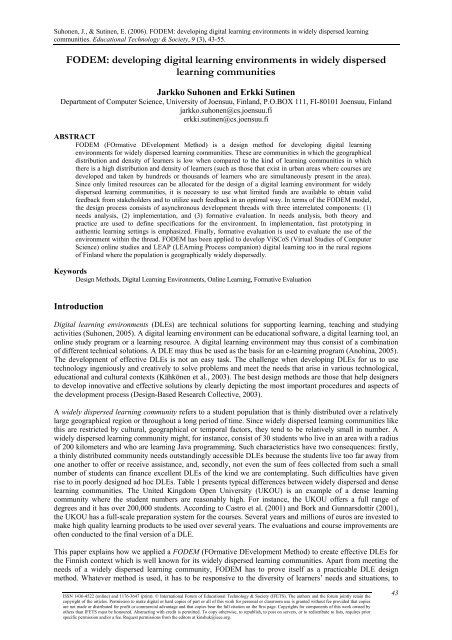July 2006 Volume 9 Number 3 - CiteSeerX
July 2006 Volume 9 Number 3 - CiteSeerX
July 2006 Volume 9 Number 3 - CiteSeerX
You also want an ePaper? Increase the reach of your titles
YUMPU automatically turns print PDFs into web optimized ePapers that Google loves.
Suhonen, J., & Sutinen, E. (<strong>2006</strong>). FODEM: developing digital learning environments in widely dispersed learning<br />
communities. Educational Technology & Society, 9 (3), 43-55.<br />
FODEM: developing digital learning environments in widely dispersed<br />
learning communities<br />
Jarkko Suhonen and Erkki Sutinen<br />
Department of Computer Science, University of Joensuu, Finland, P.O.BOX 111, FI-80101 Joensuu, Finland<br />
jarkko.suhonen@cs.joensuu.fi<br />
erkki.sutinen@cs.joensuu.fi<br />
ABSTRACT<br />
FODEM (FOrmative DEvelopment Method) is a design method for developing digital learning<br />
environments for widely dispersed learning communities. These are communities in which the geographical<br />
distribution and density of learners is low when compared to the kind of learning communities in which<br />
there is a high distribution and density of learners (such as those that exist in urban areas where courses are<br />
developed and taken by hundreds or thousands of learners who are simultaneously present in the area).<br />
Since only limited resources can be allocated for the design of a digital learning environment for widely<br />
dispersed learning communities, it is necessary to use what limited funds are available to obtain valid<br />
feedback from stakeholders and to utilize such feedback in an optimal way. In terms of the FODEM model,<br />
the design process consists of asynchronous development threads with three interrelated components: (1)<br />
needs analysis, (2) implementation, and (3) formative evaluation. In needs analysis, both theory and<br />
practice are used to define specifications for the environment. In implementation, fast prototyping in<br />
authentic learning settings is emphasized. Finally, formative evaluation is used to evaluate the use of the<br />
environment within the thread. FODEM has been applied to develop ViSCoS (Virtual Studies of Computer<br />
Science) online studies and LEAP (LEArning Process companion) digital learning too in the rural regions<br />
of Finland where the population is geographically widely dispersedly.<br />
Keywords<br />
Design Methods, Digital Learning Environments, Online Learning, Formative Evaluation<br />
Introduction<br />
Digital learning environments (DLEs) are technical solutions for supporting learning, teaching and studying<br />
activities (Suhonen, 2005). A digital learning environment can be educational software, a digital learning tool, an<br />
online study program or a learning resource. A digital learning environment may thus consist of a combination<br />
of different technical solutions. A DLE may thus be used as the basis for an e-learning program (Anohina, 2005).<br />
The development of effective DLEs is not an easy task. The challenge when developing DLEs for us to use<br />
technology ingeniously and creatively to solve problems and meet the needs that arise in various technological,<br />
educational and cultural contexts (Kähkönen et al., 2003). The best design methods are those that help designers<br />
to develop innovative and effective solutions by clearly depicting the most important procedures and aspects of<br />
the development process (Design-Based Research Collective, 2003).<br />
A widely dispersed learning community refers to a student population that is thinly distributed over a relatively<br />
large geographical region or throughout a long period of time. Since widely dispersed learning communities like<br />
this are restricted by cultural, geographical or temporal factors, they tend to be relatively small in number. A<br />
widely dispersed learning community might, for instance, consist of 30 students who live in an area with a radius<br />
of 200 kilometers and who are learning Java programming. Such characteristics have two consequences: firstly,<br />
a thinly distributed community needs outstandingly accessible DLEs because the students live too far away from<br />
one another to offer or receive assistance, and, secondly, not even the sum of fees collected from such a small<br />
number of students can finance excellent DLEs of the kind we are contemplating. Such difficulties have given<br />
rise to in poorly designed ad hoc DLEs. Table 1 presents typical differences between widely dispersed and dense<br />
learning communities. The United Kingdom Open University (UKOU) is an example of a dense learning<br />
community where the student numbers are reasonably high. For instance, the UKOU offers a full range of<br />
degrees and it has over 200,000 students. According to Castro et al. (2001) and Bork and Gunnarsdottir (2001),<br />
the UKOU has a full-scale preparation system for the courses. Several years and millions of euros are invested to<br />
make high quality learning products to be used over several years. The evaluations and course improvements are<br />
often conducted to the final version of a DLE.<br />
This paper explains how we applied a FODEM (FOrmative DEvelopment Method) to create effective DLEs for<br />
the Finnish context which is well known for its widely dispersed learning communities. Apart from meeting the<br />
needs of a widely dispersed learning community, FODEM has to prove itself as a practicable DLE design<br />
method. Whatever method is used, it has to be responsive to the diversity of learners’ needs and situations, to<br />
ISSN 1436-4522 (online) and 1176-3647 (print). © International Forum of Educational Technology & Society (IFETS). The authors and the forum jointly retain the<br />
copyright of the articles. Permission to make digital or hard copies of part or all of this work for personal or classroom use is granted without fee provided that copies<br />
are not made or distributed for profit or commercial advantage and that copies bear the full citation on the first page. Copyrights for components of this work owned by<br />
others than IFETS must be honoured. Abstracting with credit is permitted. To copy otherwise, to republish, to post on servers, or to redistribute to lists, requires prior<br />
specific permission and/or a fee. Request permissions from the editors at kinshuk@ieee.org.<br />
43

















